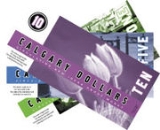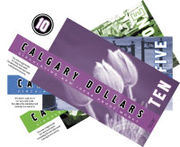
Calgary Dollars
Encyclopedia

Local currency
In economics, a local currency, in its common usage, is a currency not backed by a national government , and intended to trade only in a small area. As a tool of fiscal localism, local moneys can raise awareness of the state of the local economy, especially among those who may be unfamiliar or...
in Calgary, Alberta, Canada
Canada
Canada is a North American country consisting of ten provinces and three territories. Located in the northern part of the continent, it extends from the Atlantic Ocean in the east to the Pacific Ocean in the west, and northward into the Arctic Ocean...
. While functioning as a limited form of currency within Calgary, they are not a legal tender
Legal tender
Legal tender is a medium of payment allowed by law or recognized by a legal system to be valid for meeting a financial obligation. Paper currency is a common form of legal tender in many countries....
nor are they backed by a national government. Instead, the currency serves (according to their proponents) as a tool for community economic development
Community economic development
Community Economic Development is a field of study that actively elicits community involvement when working with government, and private sectors to build strong communities, industries, and markets...
as well as a focus for community building
Community building
Community building is a field of practices directed toward the creation or enhancement of community among individuals within a regional area or with a common interest...
. The Calgary Dollars organization considers its local currency to be implicitly sanctioned by the Canada Revenue Agency
Canada Revenue Agency
The Canada Revenue Agency is a federal agency that administers tax laws for the Government of Canada and for most provinces and territories, international trade legislation, and various social and economic benefit and incentive programs delivered through the tax system...
(CRA) based on a CRA publication which discusses the taxation of "credit units possessing a notional monetary unit value" used as a medium of exchange by local barter
Barter
Barter is a method of exchange by which goods or services are directly exchanged for other goods or services without using a medium of exchange, such as money. It is usually bilateral, but may be multilateral, and usually exists parallel to monetary systems in most developed countries, though to a...
groups.
The currency
It comes in denominations of 1, 5, 10, 25 and 50 Calgary Dollars.The bills are printed on a plastic
Plastic
A plastic material is any of a wide range of synthetic or semi-synthetic organic solids used in the manufacture of industrial products. Plastics are typically polymers of high molecular mass, and may contain other substances to improve performance and/or reduce production costs...
material in the same dimensions as the Canadian dollar
Canadian dollar
The Canadian dollar is the currency of Canada. As of 2007, the Canadian dollar is the 7th most traded currency in the world. It is abbreviated with the dollar sign $, or C$ to distinguish it from other dollar-denominated currencies...
.
In print, the currency is commonly abbreviated as "C$".
History
The currency was founded in 1996 as a project of The Arusha Centre, in Calgary. The project was originally called the "Bow Chinook Barter Community (BCBC)", and the currency was named the "Bow Chinook Hour".In 2002, the "Bow Chinook Hour" currency was replaced with "Calgary Dollars" (which was also adopted as the new name of the project).

